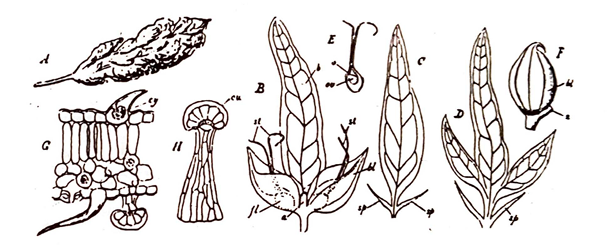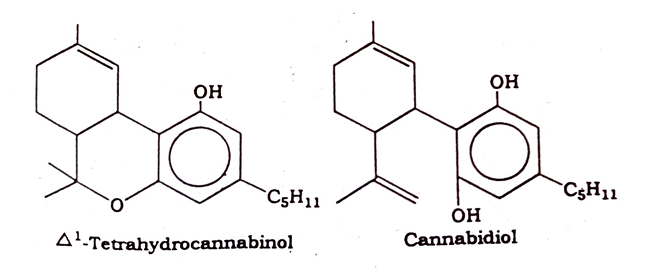Synonyms: Cannabis Indica, Indian Hemp, Marijuana
Botanical source: Cannabis consists of the flowering and fruiting tops of the female plants of Cannabis saliva Linn, an annua1 dioecious herb of the family Cannabinaceae.
Geographical source: Cannabis plant is indigenous to Central and Western Asia and is cultivated under Government control in many countries including India, East, and South Africa tropical countries and the United States of America.

Fig. 14: Cannabis. A, habit sketch of female inflorescence, B, bract and its pair of bracteoles; C, a simple bract; D, a temate bract; E, pistillate flowers, F, a fruit; G, t.s. of a bract; H, glandular trichomes. a, axillary shoot; b, bract; bl, bracteole; cu, cuticle; cy, cystolith; fl, flowers; o, ovary; ov, ovule; sp, stipule; st, style and stigma. (Reconstructed from Wallis).
Macroscopical characters: The whole drug occurs in dull green flattened masses, 10 to 30 cm long and 5 to 10 cm wide, rough, resinous and harsh to touch. Each mass consists of a stem with branches bearing numerous bracts enclosing the female flowers. Stems are cylindrical with longitudinal furrows. Bracts are simple and ternate, lanceolate in shape, about 1.5 cm long with an entire margin, alternate and stipulate. Bracteoles are boat-like and ovate in shape with acute apex. Each bracteole encloses a flower or fruit. They occur in pairs in the axil of a bract. Flowers are reddish-purple in colour; the ovary is almost enveloped with two reddish brown stigmas rising above the bracteole. Fruits are achenes, ovoid in shape and yellowish green in colour. The lower large bracts resemble the foliage leaves, which are palmate compound leaves with 3 to 5 narrowly lanceolate leaflets with serrate margins an? acute apices. All parts of the drug bear numerous hairs and large stalked glands containing the resin. The drug has a heavy powerful odour, but no distinct taste.
Microscopical characters: The cellular structures of the bracts and leaves resemble those of an ordinary dorsiventral leaf. The upper epidermis consists of cells with straight anticlinal walls, which bear unicellular, pointed curved conical trichomes, 150-250 µm long, with enlarged bases which often contain cystoliths of calcium carbonate, Glandular trichomes with a secreting head of about eight radiating club-shaped cells containing an oleo-resinous fluid are also present on the upper epidermis. Both covering trichomes and glandular trichomes occur on the lower epidermis. But the covering trichomes of this epidermis are much longer and devoid of cystoliths. Some of the glands are sessile and others have cylindrical multicellular and multiseriate stalks. Anomocytic stomata are present on the under surface of bracts and leaflets. Cluster crystals of calcium oxalate occur in the cortex and pith of the stem.
Chemical constituents: The chief constituent of the drug is a resinous substance, cannabinone, which on distillation yields a powerful narcotic, known as tetrahydrocannabinol. In addition to the resin and cannabinol, Cannabis also contains cannabidiol, the alkaloid choline and a small amount of volatile oil.

Uses: It is a strong addicting narcotic drug and causes hallucination. It is used as a sedative in mania and hysteria and also as an antispasmodic. Because of its addicting property, the use of the drug is discouraged. The various forms of Cannabis are named variously, such as Marijuana, Marihuana, Hashish, Bhang, Ganja, and Charas.

